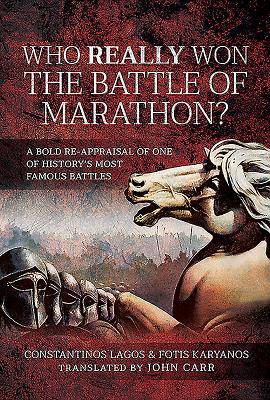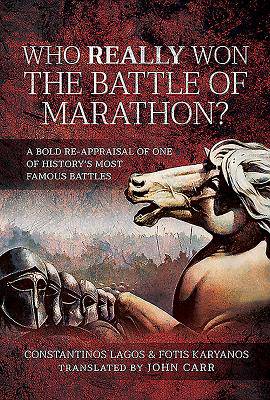
- Afhalen na 1 uur in een winkel met voorraad
- Gratis thuislevering in België vanaf € 30
- Ruim aanbod met 7 miljoen producten
- Afhalen na 1 uur in een winkel met voorraad
- Gratis thuislevering in België vanaf € 30
- Ruim aanbod met 7 miljoen producten
Zoeken
Who Really Won the Battle of Marathon?
A Bold Re-Appraisal of One of History's Most Famous Battles
Constantinos Lagos, Fotis Karyanos
Hardcover | Engels
€ 34,95
+ 69 punten
Omschrijving
This book is a bold and controversial reinterpretation of one of the most famous and decisive battles of the ancient world, overturning a number of long-held assumptions and myths about the Greek army.
The Battle of Marathon in 490 BC, where an Athenian-led Greek force defeated a Persian invasion, is one of the most decisive battles in Antiquity and has been studied for centuries. It is famed as a triumph of the Greek hoplite heavy infantry phalanx against massively superior Persian numbers. But this exciting re-assessment of the evidence, including new archaeological findings, overturns many long-held assumptions. In particular the authors argue that the Greek numerical inferiority was less marked than previously thought, largely because the hoplites were accompanied by many light infantrymen who are given unprecedented credit for their role in the fighting. The contribution of these poorer citizens, it is argued, led to the immediate strengthening of democracy in Athens.
The authors also tackle the much-debated mystery of the whereabouts of the Persian cavalry, generally thought to have been absent on the day of battle. Their bold answer is that it was not only present but played a central role in the fighting. However, the Greeks managed to defeat the Persian cavalry by their ingenious use of the terrain. Karyanos and Lagos also claim to have located the site of the Greek camp. This thoroughly researched and compelling re-assessment is an exciting new take on this justly famous event.
The Battle of Marathon in 490 BC, where an Athenian-led Greek force defeated a Persian invasion, is one of the most decisive battles in Antiquity and has been studied for centuries. It is famed as a triumph of the Greek hoplite heavy infantry phalanx against massively superior Persian numbers. But this exciting re-assessment of the evidence, including new archaeological findings, overturns many long-held assumptions. In particular the authors argue that the Greek numerical inferiority was less marked than previously thought, largely because the hoplites were accompanied by many light infantrymen who are given unprecedented credit for their role in the fighting. The contribution of these poorer citizens, it is argued, led to the immediate strengthening of democracy in Athens.
The authors also tackle the much-debated mystery of the whereabouts of the Persian cavalry, generally thought to have been absent on the day of battle. Their bold answer is that it was not only present but played a central role in the fighting. However, the Greeks managed to defeat the Persian cavalry by their ingenious use of the terrain. Karyanos and Lagos also claim to have located the site of the Greek camp. This thoroughly researched and compelling re-assessment is an exciting new take on this justly famous event.
Specificaties
Betrokkenen
- Auteur(s):
- Uitgeverij:
Inhoud
- Aantal bladzijden:
- 320
- Taal:
- Engels
Eigenschappen
- Productcode (EAN):
- 9781526758064
- Verschijningsdatum:
- 28/02/2020
- Uitvoering:
- Hardcover
- Formaat:
- Genaaid
- Afmetingen:
- 155 mm x 236 mm
- Gewicht:
- 748 g

Alleen bij Standaard Boekhandel
+ 69 punten op je klantenkaart van Standaard Boekhandel
Beoordelingen
We publiceren alleen reviews die voldoen aan de voorwaarden voor reviews. Bekijk onze voorwaarden voor reviews.











